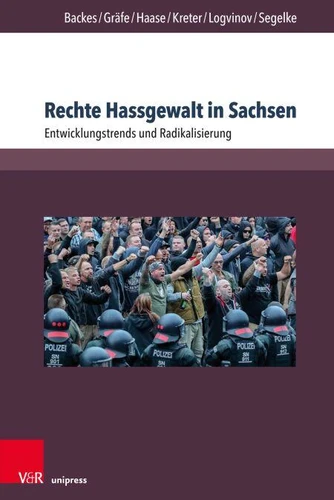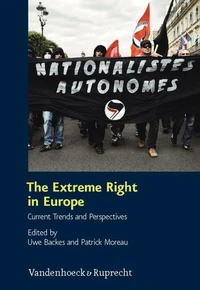Rechte Hassgewalt in Sachsen. Entwicklungstrends und Radikalisierung
Par : , , , ,Formats :
Disponible dans votre compte client Decitre ou Furet du Nord dès validation de votre commande. Le format PDF est :
- Compatible avec une lecture sur My Vivlio (smartphone, tablette, ordinateur)
- Compatible avec une lecture sur liseuses Vivlio
- Pour les liseuses autres que Vivlio, vous devez utiliser le logiciel Adobe Digital Edition. Non compatible avec la lecture sur les liseuses Kindle, Remarkable et Sony
 , qui est-ce ?
, qui est-ce ?Notre partenaire de plateforme de lecture numérique où vous retrouverez l'ensemble de vos ebooks gratuitement
Pour en savoir plus sur nos ebooks, consultez notre aide en ligne ici
- Nombre de pages279
- FormatPDF
- ISBN978-3-8470-1029-6
- EAN9783847010296
- Date de parution12/08/2019
- Protection num.pas de protection
- Taille4 Mo
- Infos supplémentairespdf
- ÉditeurV&R Unipress
Résumé
Ist der Freistaat Sachsen eine »Hochburg rechtsextremer Hassgewalt« ? Diese Leitfrage steht im Zentrum der Studie des Hannah-Arendt-Instituts. Sie erfasst die Periode vor und kurz nach der »Flüchtlingskrise« (2011-2016), zeichnet die Veränderungen im Zeitablauf nach und zieht Vergleiche zu anderen Bundesländern. Der Fokus liegt dabei auf den rechtskräftig verurteilten Gewalttätern und deren Taten.
Besondere Berücksichtigung finden herausragende Gewaltakteure wie die »Gruppe Freital« und die »Freie Kameradschaft Dresden« , die maßgeblich zur Eskalation beitrugen. Detaillierte Untersuchungen sind den ideologischen Hintergründen und Kommunikationsformen vor allem in sozialen Medien und der Rechtsrock-Musikszene gewidmet. Is the Free State of Saxony a "stronghold of extreme right-wing Hate Crime"? This key question is central for the study by the Hannah-Arendt-Institute.
The study includes the period of time before and after the "refugee crisis" (2011-2016), analyses change during this time and compares Saxony with other federal states in Germany. The central research objects are convicted perpetrators of violence and their crimes. Particular consideration was given to prominent violent groups like "Gruppe Freital" and "Freie Kameradschaft Dresden", which contributed significantly to the escalation of violence in Saxony.
In-depth analysis about ideological backgrounds and forms of communication via social media and the White Power Music Scene are also provided within this study.
Besondere Berücksichtigung finden herausragende Gewaltakteure wie die »Gruppe Freital« und die »Freie Kameradschaft Dresden« , die maßgeblich zur Eskalation beitrugen. Detaillierte Untersuchungen sind den ideologischen Hintergründen und Kommunikationsformen vor allem in sozialen Medien und der Rechtsrock-Musikszene gewidmet. Is the Free State of Saxony a "stronghold of extreme right-wing Hate Crime"? This key question is central for the study by the Hannah-Arendt-Institute.
The study includes the period of time before and after the "refugee crisis" (2011-2016), analyses change during this time and compares Saxony with other federal states in Germany. The central research objects are convicted perpetrators of violence and their crimes. Particular consideration was given to prominent violent groups like "Gruppe Freital" and "Freie Kameradschaft Dresden", which contributed significantly to the escalation of violence in Saxony.
In-depth analysis about ideological backgrounds and forms of communication via social media and the White Power Music Scene are also provided within this study.
Ist der Freistaat Sachsen eine »Hochburg rechtsextremer Hassgewalt« ? Diese Leitfrage steht im Zentrum der Studie des Hannah-Arendt-Instituts. Sie erfasst die Periode vor und kurz nach der »Flüchtlingskrise« (2011-2016), zeichnet die Veränderungen im Zeitablauf nach und zieht Vergleiche zu anderen Bundesländern. Der Fokus liegt dabei auf den rechtskräftig verurteilten Gewalttätern und deren Taten.
Besondere Berücksichtigung finden herausragende Gewaltakteure wie die »Gruppe Freital« und die »Freie Kameradschaft Dresden« , die maßgeblich zur Eskalation beitrugen. Detaillierte Untersuchungen sind den ideologischen Hintergründen und Kommunikationsformen vor allem in sozialen Medien und der Rechtsrock-Musikszene gewidmet. Is the Free State of Saxony a "stronghold of extreme right-wing Hate Crime"? This key question is central for the study by the Hannah-Arendt-Institute.
The study includes the period of time before and after the "refugee crisis" (2011-2016), analyses change during this time and compares Saxony with other federal states in Germany. The central research objects are convicted perpetrators of violence and their crimes. Particular consideration was given to prominent violent groups like "Gruppe Freital" and "Freie Kameradschaft Dresden", which contributed significantly to the escalation of violence in Saxony.
In-depth analysis about ideological backgrounds and forms of communication via social media and the White Power Music Scene are also provided within this study.
Besondere Berücksichtigung finden herausragende Gewaltakteure wie die »Gruppe Freital« und die »Freie Kameradschaft Dresden« , die maßgeblich zur Eskalation beitrugen. Detaillierte Untersuchungen sind den ideologischen Hintergründen und Kommunikationsformen vor allem in sozialen Medien und der Rechtsrock-Musikszene gewidmet. Is the Free State of Saxony a "stronghold of extreme right-wing Hate Crime"? This key question is central for the study by the Hannah-Arendt-Institute.
The study includes the period of time before and after the "refugee crisis" (2011-2016), analyses change during this time and compares Saxony with other federal states in Germany. The central research objects are convicted perpetrators of violence and their crimes. Particular consideration was given to prominent violent groups like "Gruppe Freital" and "Freie Kameradschaft Dresden", which contributed significantly to the escalation of violence in Saxony.
In-depth analysis about ideological backgrounds and forms of communication via social media and the White Power Music Scene are also provided within this study.







